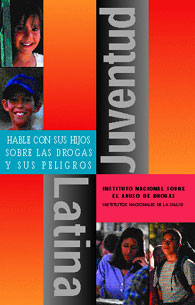Why is it important that NIDA reach out to Hispanic communities in their own language? Hispanic/Latino peoples constitute the fastest growing population group in the Nation. NIDA's Monitoring the Future survey for 2000 showed that Hispanic 12th-graders had the highest rates of reported use for crack cocaine and ecstasy. For other drugs, the Hispanic students' rates were lower than those of white students and higher than rates for African Americans.
NIDA Director Dr. Alan I. Leshner has pointed out that drug abuse and addiction are "equal opportunity destroyers," touching every race, culture, and socioeconomic level.
Translations
Two of NIDA's most popular publications, its marijuana booklets, have been translated into Spanish. La marihuana: Lo que los padres deben saber (Marijuana: What Parents Need To Know) explains how marijuana is used, who uses it, and how it affects users. The booklet also provides information to help parents prevent or detect marijuana use by their children. La marihuana: Información para los adolescentes (Marijuana: Facts for Teens) describes marijuana's short- and long-term effects on health, learning, and performance in sports and other activities.
Another popular booklet from NIDA is Cómo prevenir el uso de drogas en los niños y los adolescentes (Preventing Drug Use Among Children and Adolescents). The booklet describes principles of drug abuse prevention developed through scientific research. Proven approaches to prevention that families, schools, and communities can use are described.
Principios de tratamientos para la drogadicción (Principles of Drug Addiction Treatment) provides research-based information about addiction, drug treatment, and recovery. It helps guide new patients in getting the most from their treatment and warns about possible difficulties during treatment and recovery.
The pamphlets in NIDA's Research Report Series simplify the science of research findings for the educated lay public, legislators, educational groups, and practitioners. To date, four Research Reports have been produced in Spanish:
- Abuso de inhalantes (Inhalant Abuse) presents information on the types of inhalants, the consequences of their use, who is abusing inhalants, and how to recognize inhalant abuse.
- La metanfetamina abuso y adicción (Methamphetamine Abuse and Addiction) includes a description of the potent psychostimulant, details of the drug's effects, and the scope of methamphetamine abuse in the United States.
- Cocaína adicción y abuso (Cocaine Abuse and Addiction) compiles scientific information on cocaine and explains the harmful effects of cocaine abuse.
- Medicamentos de prescripción abuso y adicción (Prescription Drugs Abuse and Addiction) describes the most commonly abused prescription drugs and how health professionals and patients can prevent or avoid misuse of prescribed medications.
Spanish-Only Publications
One recent brochure, published only in Spanish, is designed to help Spanish-speaking families talk together about issues of drug abuse and related health risks. Juventud latina - Hable con sus hijos sobre las drogas y sus peligros (Latino Youth: Speak to Your Children About Drugs and Their Dangers) offers the latest information on the effects of abused drugs and presents strategies for prevention and treatment of addiction. To ensure that the brochure would be useful and used, NIDA elicited input from Hispanic/Latino parents, young people, and community health professionals from across the Nation.
Juventud Latina is part of a bilingual campaign that includes radio and television public service announcements (PSAs) carrying the overriding message "Keep your brain healthy: Don't use drugs." In one series of PSAs, Latino teenagers urge their peers to talk with parents about drugs; in a parallel series, the teens address parents, asking them to take the initiative in discussing drugs with their children.

